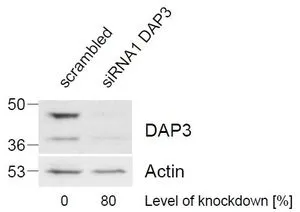DAP3 antibody [N1C2-2]
GTX113864
ApplicationsImmunoFluorescence, Western Blot, ImmunoCytoChemistry, ImmunoHistoChemistry, ImmunoHistoChemistry Paraffin
Product group Antibodies
TargetDAP3
Overview
- SupplierGeneTex
- Product NameDAP3 antibody [N1C2-2]
- Delivery Days Customer9
- Application Supplier NoteWB: 1:500-1:3000. ICC/IF: 1:100-1:1000. IHC-P: 1:100-1:1000. *Optimal dilutions/concentrations should be determined by the researcher.Not tested in other applications.
- ApplicationsImmunoFluorescence, Western Blot, ImmunoCytoChemistry, ImmunoHistoChemistry, ImmunoHistoChemistry Paraffin
- CertificationResearch Use Only
- ClonalityPolyclonal
- Concentration0.7 mg/ml
- ConjugateUnconjugated
- Gene ID7818
- Target nameDAP3
- Target descriptiondeath associated protein 3
- Target synonymsDAP-3, MRP-S29, MRPS29, PRLTS7, S29mt, bMRP-10, mS29, small ribosomal subunit protein mS29, 28S ribosomal protein S29, mitochondrial, ionizing radiation resistance conferring protein, mitochondrial 28S ribosomal protein S29, mitochondrial small ribosomal subunit protein mS29
- HostRabbit
- IsotypeIgG
- Protein IDP51398
- Protein NameSmall ribosomal subunit protein mS29
- Scientific DescriptionMammalian mitochondrial ribosomal proteins are encoded by nuclear genes and help in protein synthesis within the mitochondrion. Mitochondrial ribosomes (mitoribosomes) consist of a small 28S subunit and a large 39S subunit. They have an estimated 75% protein to rRNA composition compared to prokaryotic ribosomes, where this ratio is reversed. Another difference between mammalian mitoribosomes and prokaryotic ribosomes is that the latter contain a 5S rRNA. Among different species, the proteins comprising the mitoribosome differ greatly in sequence, and sometimes in biochemical properties, which prevents easy recognition by sequence homology. This gene encodes a 28S subunit protein that also participates in apoptotic pathways which are initiated by tumor necrosis factor-alpha, Fas ligand, and gamma interferon. This protein potentially binds ATP/GTP and might be a functional partner of the mitoribosomal protein S27. Splice variants that differ in the 5 UTR have been found for this gene; both variants encode the same protein. Pseudogenes corresponding to this gene are found on chromosomes 1q and 2q. [provided by RefSeq]
- Storage Instruction-20°C or -80°C,2°C to 8°C
- UNSPSC12352203
References
- Min S, Lee YK, Hong J, et al. MRPS31 loss is a key driver of mitochondrial deregulation and hepatocellular carcinoma aggressiveness. Cell Death Dis. 2021,12(11):1076. doi: 10.1038/s41419-021-04370-8Read this paper
- Lee YK, Lim JJ, Jeoun UW, et al. Lactate-mediated mitoribosomal defects impair mitochondrial oxidative phosphorylation and promote hepatoma cell invasiveness. J Biol Chem. 2017,292(49):20208-20217. doi: 10.1074/jbc.M117.809012Read this paper







